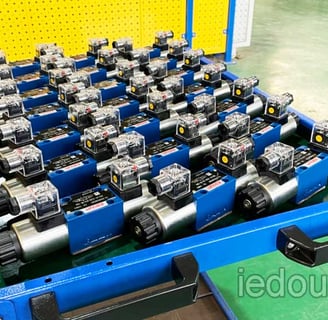Hydraulic Directional Valves: FAQs
yuken and rexroth typt valve
10/30/20242 min baca


Introduction to Yuken and Rexroch Type Hydraulic Directional Valves
YUKEN type DSG-01-3C2-D24-N1-50 Hydraulic directional valves play a crucial role in controlling the flow of hydraulic fluids in systems. They determine the movement of actuators, preventing potential system failures. Understanding these valves can assist both novice users and experienced professionals in achieving optimal hydraulic system performance.
Common Questions About Hydraulic Directional Valves
Rexroht type 4WE6E61B/CG24N9Z5L As hydraulic systems grow in popularity across various industries, questions surrounding hydraulic directional valves become more prevalent. Here are some of the most commonly asked questions:
1. What are Hydraulic Directional Valves Used For?
DSG-03-3C2-D24-50 Hydraulic directional valves are primarily used to control the direction of hydraulic fluid flow. They ensure that hydraulic actuators and motors receive the necessary fluid to perform actions such as lifting, lowering, and rotating. By directing flow paths, these valves enable complex movements in machinery and equipment.
2. How Do Hydraulic Directional Valves Work?
These valves operate on the principles of hydraulic pressure and mechanical design. When the valve is actuated, either manually or electronically, it shifts to open or close specific flow paths, directing the fluid to the corresponding outlet. This action is vital for enabling the desired operation of hydraulic systems.
3. What Types of Hydraulic Directional Valves Are Available?
Hydraulic directional valves come in various configurations, including 2-way, 3-way, and 4-way valves. Each type serves specific functions and is best suited for different applications. For instance, a 2-way valve can either allow or block flow, while a 4-way valve can direct flow to multiple outputs or back to a reservoir.
4. How to Choose the Right Hydraulic Directional Valve?
Choosing the right hydraulic directional valve depends on several factors, including system pressure, flow rate, and the specific application requirements. It's essential to consider the design and compatibility of the valve with other system components.
5. What Maintenance is Required for Hydraulic Directional Valves?
Regular maintenance is crucial for ensuring optimal performance of hydraulic directional valves. This includes checking for leaks, monitoring for signs of wear and tear, and ensuring proper actuation. Additionally, cleaning hydraulic filters remains essential to prevent particles from entering the system.
Conclusion
In summary, hydraulic directional valves are integral to the functionality of hydraulic systems. By understanding their purpose and operation, users can enhance the reliability and efficiency of their equipment. With the right knowledge, maintaining these valves can vastly improve system longevity and performance.
